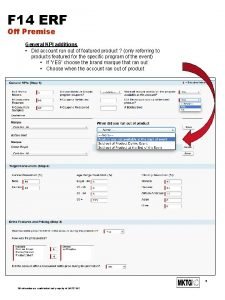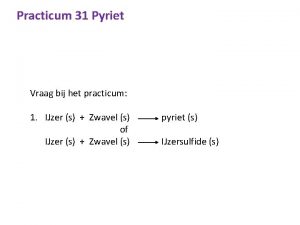MKTG 4763 Marketing Analytics Practicum Pushkar Raj Fall













- Slides: 13

MKTG 4763 - Marketing Analytics Practicum Pushkar Raj Fall 2018 Week – 07 (October 10 th, 2018)

What are we covering today? Topics: • ACV • Distribution • Sales Velocity

Breaking Down Sales Distribution Velocity (How widely is your product available? ) (How well does your product sell when it is available? ) Sales = Distribution * Velocity

How do we measure distribution? Numeric Distribution All Commodity Volume (ACV) Numeric Distribution % = Number of Outlets carrying product (#) Total Number of Outlets in the Market (#) The main use of numeric distribution is to understand how many physical locations stock a product or brand.

All Commodity Volume (ACV) All commodity volume (ACV) is the estimated total volume of sales at a particular retail outlet. ACV from IRI is listed in Millions of Dollars. 51. 51099 is read as $51. 5 million dollars in sales. For grocery stores, the ACV includes sales from cards, tobacco, alcohol, gift cards and all other categories.

ACV Example Small Store Large Store Cleveland grocery market is worth $259. 60 million dollars

ACV versus Numerical Distribution ignores the different sizes of the stores in terms of how much business or products are each of them selling – Treats all stores equally ACV calculations enables a manufacturer or vendor to assess its distribution in a market based on the % of the Market’s ACV to which it has access. % Stores Selling is the percent of the ACV in the Market that sold at least one unit of an item during a specific period.

% ACV

Sales Velocity – Why it is important? Say there are two brands, both with sales of 3, 000 units. But the forces driving their sales differ. Product A has low distribution and high velocity. Product B has excellent distribution but weak velocity, relative to Product A.

Sales Velocity – Why it is important? The difference between the measures influences the approach to increase sales. Distribution is ultimately under the retailer’s control. For Product A, you would make a case with the retailer for greater distribution to increase sales. Velocity can reflect a variety of factors, many of which are under the manufacturer’s control. For Product B, your next step would be to dig in and assess the factors that impact velocity, such as price, promotion, variety or competitive factors, and then prioritize your marketing programs based on your findings.

Sales Velocity – Two measures The two major velocity measures are: 1. Sales per Point of Distribution (SPPD) 2. Sales per Million (Sales per $MM ACV)

Sales Velocity – How do we compute? Sales per Point of Distribution (SPPD) 1. Analysis is appropriate for market area 2. Need to calculate total ACV for the market area and each stores percent of ACV 3. Change percent ACV to points (percentage is reformatted as a whole number) 4. Total dollars or total units for the brand is summarized for each store 5. Divide total units or total dollars by the ACV points for that store

Sales Velocity – Sales per Point of Distribution (SPPD) SPPD can be expressed in dollars, units, or volume per point of distribution.

























